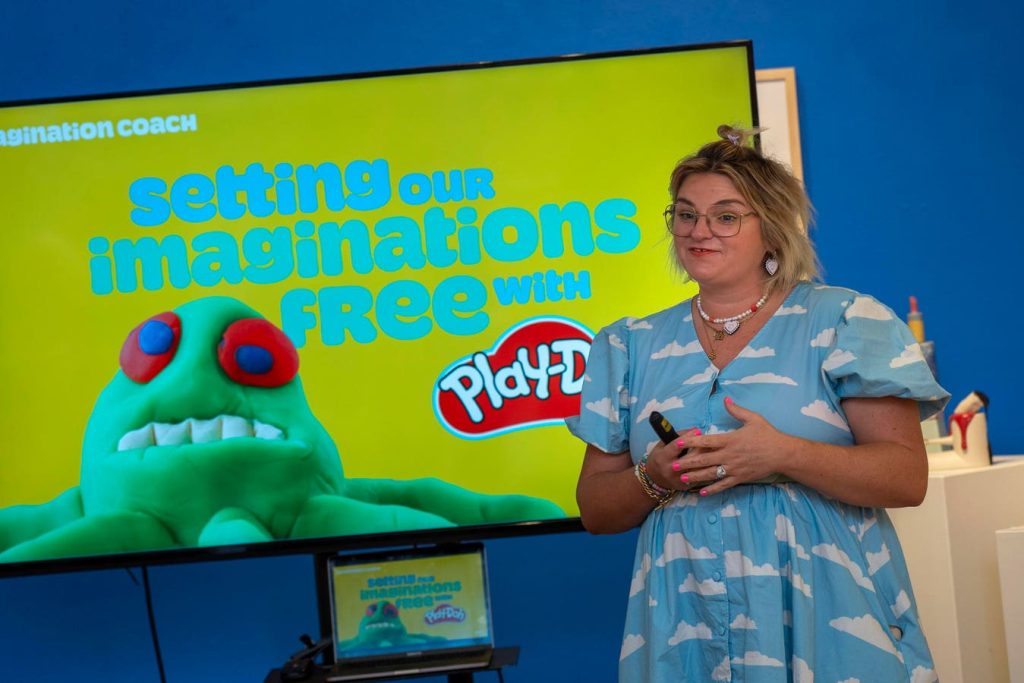Innovation is the face of change and advancement for civilizations, world power and brands looking to make a positive impact. Creativity on the production side and the leadership team are at the core of modernization. Lytho’s creativity study stated that 89% of people surveyed believe creative work is important to meeting business objectives.
But what drives creativity? Imagination. Companies and researchers haven’t even scratched the surface of how fostering imagination in the workplace leads to elevated levels of creative solutions and innovation. However, Hasbro’s PLAY-DOH team took the first step at looking at the effects of imagination in childhood and how they can nurture it while growing up in a one-of-a-kind study, Imagination Is A Super Power. Understanding imagination in children helps us know how to utilize it in adulthood and the workplace.
“According to our study, imagination is believed to simultaneously support the development of social, creative and emotional skills needed immediately in childhood and, therefore, foundationally to thrive in adulthood,” states Tamara Grindrod, Hasbro global play leader & SVP, creativity & PLAY-DOH brand, during an interview. “From the PLAY-DOH perspective, embracing freedom from failure as a child unlocks the free flow of imagination and creativity. If you don’t like how something is turning out, don’t be afraid to squish it and start again. That confidence building in childhood inspires adults to explore new possibilities and take on challenges, freeing minds to think differently. From our perspective, the solutions to today’s challenges haven’t yet been imagined.”
What started as a wallpaper cleaner in the early 19th century has been a childhood staple since the 1950s. PLAY-DOH, inducted into the National Toy Hall of Fame in 1998, supports endless hours of play among children. As the brand continues to evolve, it enlisted Emma Worrollo, founder of the Playful Den, to conduct the study.
Worrollo gained a reputation with her international research agency conducting global studies for primary children’s brands worldwide. Over the years, she wanted to foster her own imagination. She sold the agency recently and started her journey as a solopreneur in the creative space, still focusing on children’s development and Generation Alpha. During the pandemic, she became an accidental influencer with her content on how to engage in play with children.
Last year, PLAY-DOH began to think about how to evolve the brand. The genesis behind the study was wanting to understand the pieces that makeup imagination.
“If I say imagination, you inherently know what that means,” shares Christina Stahlkopf, senior manager global consumer insights at Hasbro, during a Zoom interview. “But if I asked you to define it, it’s a little bit trickier. But is it really? What does it do? What are the benefits? So we wanted to go out and understand a broad view of imagination but also grounded very much in the reality of the day-to-day lives of children and families.”
The study launched by asking different professionals, from scientists to artists to psychologists, what brain science was around imagination; this provided the foundational understanding. Additionally, they wanted to see how imagination showed up in people’s lives; that gave the team a framework for reaching out to families.
The study revealed imagination is a “use it or lose it” muscle. Sixty-four percent of teens (age 13-17) agree that their loss of imagination progresses as they age, and 71% of parents feel that children are less imaginative than they used to be. Continued access to various imagination challenges and experiences is needed for the imagination to thrive. Additionally, imagination responds to time and encouragement and thrives on open-ended, playful experiences.
“I call PLAY-DOH the language of imagination,” Worrollo details. “You can’t always see imagination because it’s happening within and it is this exploration of possibilities. And that is what you do just by manipulating [the material], by making shapes and character creations, you are exploring possibilities. It’s not harsh; it doesn’t have edges. It doesn’t have an endpoint. That’s what we found in the research—there’s a strong correlation between PLAY-DOH and no fear of failure.”
The heritage brand encourages parents and children to work on strengthening their imagination muscle, which develops confidence and empowerment to dream and create out-of-the-box solutions to problems. For this next generation, the longer they practice imagination, the more creative the future will be.
As Grindrod, Worrollo and the rest of PLAY-DOH’s team work on pivoting mindsets around imagination, they share the following advice:
- Be willing to find resources that give you a chance to create without boundaries. When you allow yourself the freedom, your children will model your actions.
- Value your imagination; make space for it. Whether it’s setting aside a block of time or dedicating a room to creativity, develop the muscle.
- Encourage yourself and your children to take risks, go beyond barriers and learn that there is no failure when creating something imaginary.
“Leadership at its core is imagination,” Jason Loik, toy inventor and sculptor, comments during an interview. “Everything that a leader does is based on imagination. Imagination is what you have going on upstairs. Creativity is the ability to turn imagination into actuality. We use those terms interchangeably, but I think they’re quite distinct. You can’t have one without the other. For leadership, they’re not necessarily manifesting it in physical form. But that leadership is the manifestation and you need that creativity and you need that inspiration.”
Read the full article here










